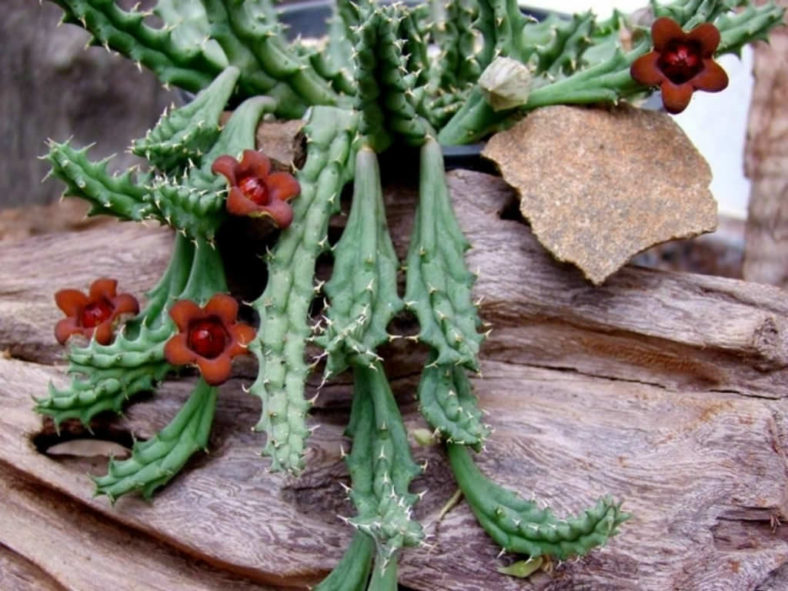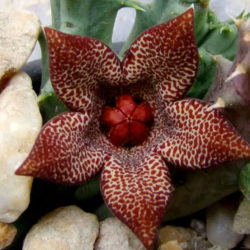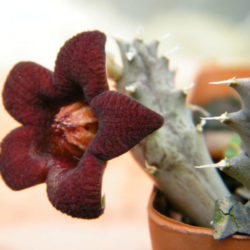Scientific Name
Piaranthus decipiens (N.E.Br.) Bruyns
Synonym(s)
Ceropegia decipiens, Huerniopsis decipiens
Scientific Classification
Family: Apocynaceae
Subfamily: Asclepiadoideae
Genus: Huerniopsis
Description
Piaranthus decipiens, formerly known as Huerniopsis decipiens, is a succulent plant with decumbent stems with tubercles mainly joined into four angles along the stems. It forms diffuse mats that may reach a diameter of 3.3 feet (1 m). Stems are dull green to grey, often mottled with purple. They usually have a distinctly narrow base and grow up to 6 inches (15 cm) long and 0.8 inches (2 cm) thick. Each tubercle is initially tipped with a small, narrowly deltoid leaf rudiment that dries out and persists for a while as a whitish husk.
Flowers are produced in small numbers towards the tips of the younger stems and open simultaneously or with long intervals in late summer or fall. They are up to 1.2 inches (3 cm) in diameter, usually brown becoming paler in the tube and with low rounded papillae, each with a small apical bristle. Occasionally the whole flower is prettily mottled with yellow on brown.
Origin
Piaranthus decipiens is native to Namibia, Botswana, and South Africa. It grows in sandy and rocky soil, usually under small bushes around the northern and eastern edges of the driest parts of the Kalahari.

Hardiness
USDA hardiness zone 10a to 11b: from 30 °F (−1.1 °C) to 50 °F (+10 °C).
How to Grow and Care
Stapeliads are relatively easy to grow. However, they should be treated as outdoor plants as they will easily rot indoors and cannot flower without exposure to outdoor temperature fluctuations. They should be grown under cover so that watering can be controlled. They require a reasonable amount of sunlight to promote flowering and maintain a well-shaped plant. Very shady positions will produce very poor flowering. Stapeliads come from climates where they survive extremely high temperatures in the summer months, so most growth is in spring and autumn, with flowering in autumn when the weather starts to cool down. Water in moderation when needed in the growing season, ensuring the soil is fairly dried out between waterings. Do not water between November 1 and March 1.
The easiest and best way to propagate Stapeliads is from stem cuttings which can be taken virtually throughout the year. Seed is also a method of propagation.
See more at How to Grow and Care for Stapeliads.
Links
- Back to genus Huerniopsis
- Succupedia: Browse succulents by Scientific Name, Common Name, Genus, Family, USDA Hardiness Zone, Origin, or cacti by Genus
Photo Gallery
Click on a photo to see a larger version.



